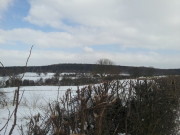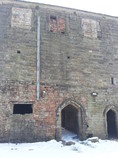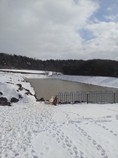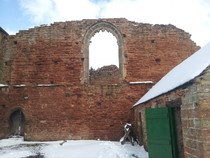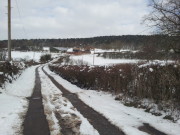Travel Log Monday 25th March
I received an e-mail first thing from Ann, the proprietor of Beauvale Priory, warning me about the ice and snow on their drive. I decided to park up in the lane and walk down the farm track so I wouldn’t get stuck.
Shortly before leaving England for foreign climes I had found out about the existence of this former Carthusian monastery. It was founded in 1343, the third Charterhouse in the British Isles, and fell victim to dissolution under Henry VIII. It has some gruesome history in that two of its priors, Robert Lawrence and John Houghton, were among the first to be executed in 1535 by a “traitor’s” death at Tyburn for refusing to swear the Oath of Supremacy; this was even before the axe fell on Sir Thomas Moore.
Carthusians were viewed as austere and committed since they lived an ascetic and relatively plain life. It was a shock that these brothers were targeted by the King, who, it is surmised, wanted these well-respected monks to toe the line and thereby encourage others to follow suit. The ruins at Beauvale in the parish of Greasley are testament to the damage inflicted on religious houses in the Reformation.
I was stunned to find details of this place since I was born in this parish, only 2 miles away from the Priory; in fact the infant and junior schools I attended as a child were called Beauvale. My father, when settling in England and working for the coalboard became deputy shot-firer at Moorgreen colliery, just down the road. When part of the pit closed in the 1960s, he took the opportunity to leave, and we moved from the area.
I learnt from Ann that it is not unusual for local people to be unaware of the existence of the priory or any of its history. It is only due to the commitment of this lady and her husband when they bought the farm and renovated the farmhouse that the priory has been saved. English Heritage have undertaken to make secure the walls, yet the original idea was to knock it all down. Fortunately Ann is not an iconoclast!
The setting truly is a beautiful valley, this much was obvious even as the fields and woods lay
under at least a foot of snow. I had read enough on the website to know that the present tea rooms that have been open for a year are housed in the former gatehouse. Although it is now one large
room, signs of old doorways are still visible. If you look at any medieval religious building, you can usually see there are signs of old architectural features.
At St Denis Basilica (see Sun 17th March log) there were the vestiges of arched entrance doors into what used to be the abbey cloisters. In any medieval village church in this country, a doorway can usually be seen above head height in a side wall - it now looks like it leads into thin air, but at one time it would have been the access point to the rood loft. Rood is Saxon for cross and rood lofts used to house depictions of Calvary, but they were torn down during the Reformation.
This morning, Ann generously gave me a guided tour, despite the freezing cold conditions. Apart from the gatehouse, the prior’s house is probably the best preserved building on the site. Over the centuries, many of the building materials have been removed from the monastery and reused, the altar stone from the chapel having been found in the farmhouse; it had been used as a serviceable fireplace lintel.
The snow prevented a good view of the earthworks showing the outline of the monks’ cells and cloister, or the edge of the outer wall that originally surrounded the whole site and joined up with the gatehouse. These Carthusian abbeys, although housing only 12 monks and a prior were in fact quite large. Beauvale was no exception.
The monks were self-sufficient for food, and the present owners have re-flooded the fish pond were once were kept tench and later carp. I say self-sufficient, but there would have been a number of lay brothers living close by who would probably have done all the manual work and food preparation. It is likely that the lay brothers of Beauvale lived up on the ridge opposite, where a farm now lies.
The present site of the chapel still has two expanses of wall, the south being most intact: it comprises the monks’ entrance and the masonry of a window on the south facing side. There is now a standing memorial stone which commemorates the death of the two Carthusian priors, Robert Lawrence and John Houghton. There is a procession and service held here every year on the 4th May, the anniversary of their executions. I needed time for more reflection on what has torn us apart religiously and culturally in this land.
I have written earlier (see Friday 15th March) about my literary interest in the Carthusian translation of Marguerite’s Mirror into Middle English and the three extant manuscripts; also that there was a Chartreuse just outside of Valenciennes, a mere 20 minutes on foot from the beguinage which lay further down the river Rhônelle. I had made a further discovery, that there is in existence one literary item of Beauvale provenance: an English translation of ‘lives’ of French lay women who were deemed holy. You can see where my mind is going with this…. although I must add that none of that translated text is about Marguerite.
Ann told me about the scholar who had written the booklet on the Priory and who is also close to finishing a translation of the Beauvale Cartulary (a sort of log or record of the monastery). She promised to put me in touch with her so I can find out more. I thanked Ann for her generosity with her time and promised I’d be back in more clement weather. I asked if I could take some more photos and she was glad to give permission.
I am now at the end of my research journey, but I feel a new chapter is about to begin. The
Carthusian lead is so exciting.
Marguerite tells of the long road that lies between the first stage of the spiritual journey of
the soul, and the seventh stage of grace. There is still a long way for me to go. I returned to the road and got into my Skoda.
We will definitely be back.


